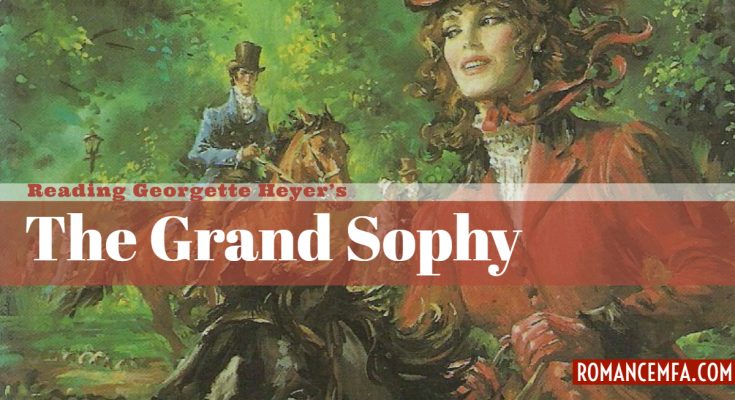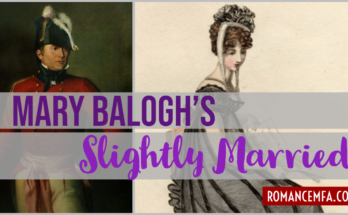With over thirty romance novels published between 1921 an 1974, Georgette Heyer is to Regency romance as Agatha Christie is to detective novels. I had a lot of trouble choosing which of her many novels to put on the syllabus, but eventually went with The Grand Sophy as a first read from this prolific and influential romance author.
Book details:
Title: The Grand Sophy
Author: Georgette Heyer
Original publication date: 1950
Setting time & place: 1816 London
He is… a wealthy 26 year-old running his extended family household and preparing to marry a very proper young lady.
She is… his intelligent, independent-minded 20 year old cousin.
Reasons to read this title: It’s known for its tight plotting.
My review of The Grand Sophy
Is it a romance novel? Yes. After many complications and much confusion, everyone is on track to marry the right partners.
Is it a must read romance novel? While Heyer is a must read author, I’m not convinced that this is the right one to read if you’re only reading one.
Just before I started reading this book, I was reminded of Jeeves & Wooster, an excellent television series based on P.G. Wodehouse’s stories and starring young Hugh Laurie and Stephen Fry. As I started reading the adventures of Sophy and the hapless persons who fall under her influence, I kept thinking about Wodehouse. Heyer’s heroine would fit right into one of his stories. She has the aristocratic background of Bertie Wooster, but the manipulative intelligence of Jeeves. You can find an excellent plot summary and discussion in the Tor.com piece by Mari Ness, which also addresses the icky anti-Semitic scene in the book. If you haven’t read it, Sophy enters the scene to find several ill-matched marriages on the near horizon. By the end of the book Sophy has managed to get everyone (including herself) straightened out and engaged to the proper people, through a lot of shenanigans which include facing down a terrible stereotype of a criminal Jewish moneylender.
Comparing The Grand Sophy to the historical romances I have read — both those written in previous eras, and those written in the last twenty years — I note three things.
First, the setting and language and scenes of the novel are the same that show up repeatedly in pretty much every Regency romance ever. There is a ball. There is a house on Berkeley Square. There is a weeping female who is referred to as a “watering pot.” There are men who are rakes. The men go to White’s and box with Gentleman Jackson. (Forget about the proliferation of Dukes in Regencies — I want to know how big Gentleman Jackon’s establishment is, and how every Regency hero manages to spend time there. The scheduling must be a nightmare.) There are men with gambling debts which cause trouble for their families. I understand it’s period detail, but it’s a number of very specific details that I have seen reshuffled in countless Regency romances after Heyer. And now I see where they’ve come from.
Second, while the wallpaper is the same, the emotional content is not. There are no burning kisses here, no clandestine meetings in libraries. One young lady attempts to slip out onto the balcony during a ball with her love interest and is immediately followed by several of her nosy and overprotective relatives. I wasn’t expecting Heyer to go into sexy details — there is no danger for any of her characters ending up pregnant — but I was surprised at the comparative remoteness of the narrative voice. In more recently written romances, whether the bedroom door is open or closed, I think there is a lot more depth of insight into the characters’ emotional states than Heyer gives. Here’s a post from Romance University on writing “deep POV”, which is what I notice Heyer doesn’t do.
Finally, I was a bit surprised by the romantic pairing. Sophy comes to live with her aunt, and her many cousins, including Charles Rivenhall. I don’t expect people to marry their cousins, so I spent the first third of the book waiting for the actual hero to appear. He didn’t. Sophy ends the book engaged to her first cousin.
Reading reactions and reviews to The Grand Sophy by others after my own reading of the book, I noticed that Sophy is mentioned as not fitting the mold of other Heyer characters. Since I had so much trouble choosing which Heyer to include on the syllabus, since she was so prolific, and since she is widely read by many readers… I’m going to do something I haven’t done before: add a second title from Heyer to the syllabus. Plus, after all the 600-1000 page books I read in the mid-century love stories unit (*coughcoughForeverAmbercoughcough*), The Grand Sophy felt extremely short!
Tune in next week to see my second Heyer read! If you need more Heyer discussion in the meantime, I recommend looking through the Tor.com series with Mari Ness rereading nearly 40 of Heyer’s books.



